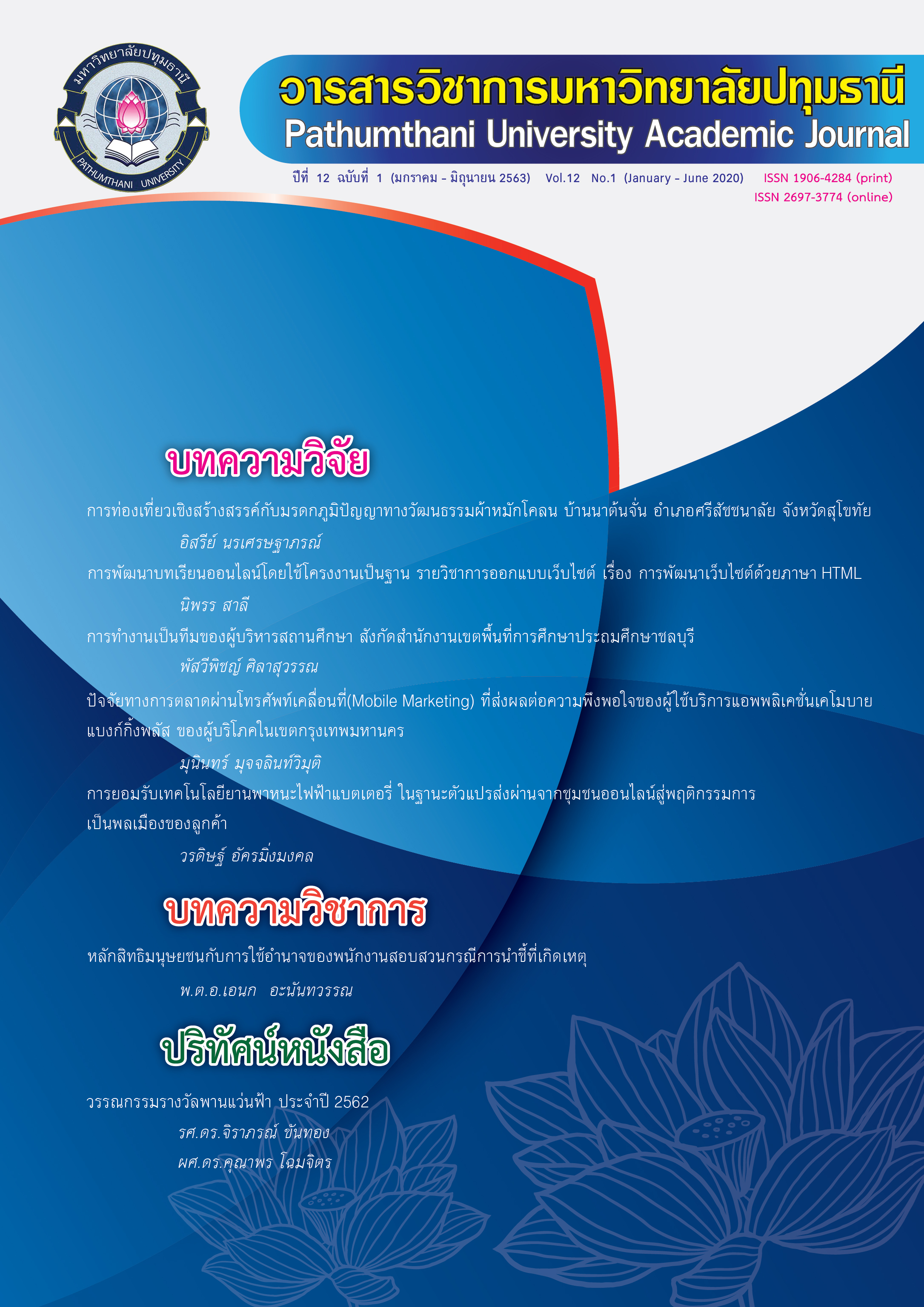DEVELOPMENT OF BLENDED LEARNING MODEL IN INTRODUCTION TO APPLIED HYDRAULICS AND PNEUMATIC COURSE FOR UNDERGRADUATE STUDENTS
Keywords:
Blended learning, Applied Hydraulic and PneumaticAbstract
This dissertation aims to develop the Blended Learning model in Applied Hydraulic and Pneumatic course for undergraduate students. There are four specific aims: 1) To Study the Body of Content and develop the Blended Learning model in Applied Hydraulic and Pneumatic course for undergraduate students. 2) To Compare the Learning Achievements before and after using the Blended Learning model. 3) To investigate students' satisfaction towards the Blended Learning model. The sample group consisted of 30 undergraduate students of Rajamangala University of Technology Phra Nakhon, in the 1/2019 Semester. They were selected by purposive sampling. The research instruments were 1) Blended Learning model in Applied Hydraulic and Pneumatic course for undergraduate students, 2) pretest -posttest evaluation form of academic achievement, and 3) learner satisfaction survey form. Data were analyzed by mean, percentage, standard deviation and t-test. The results were as follows : 1) Assessing the quality of the integrated teaching and learning model the efficiency of the developed model was 80.50/87.64 that was relevant with the 80/80 setting criteria. 2) Learning achievement of the students after learning using the developed model was high than before using statistical significant difference at .05 level. 3) The students' satisfaction of the learning using the developed model was at the high level ( = 3.83, S.D. = .95).
References
ทรงลักษณ์ สกุลวิจิตรสินธุ. (2560). “การใช้เทคโนโลยีสารสนเทศ เพื่อการเรียนรู้ร่วมกัน ทางออนไลน์”. Veridian E-Journal. ปีที่ 10 ฉบับที่ 2. หน้า 437-450.
นวลพรรณ ไชยมา. (2554). การพัฒนารูปแบบการจัดการเรียนการสอนแบบผสมผสาน โดยการประยุกต์ใช้เทคโนโลยีสารสนเทศ เพื่อพัฒนาทักษะการคิดขั้นสูงสำหรับนักศึกษาสถาบันการพลศึกษา. วิทยาเขตเพชรบูรณ์. วิทยานิพนธ์ปริญญาปรัชญาดุษฎีบัณฑิต. สาขาวิชาเทคโนโลยีการศึกษา. มหาวิทยาลัยขอนแก่น.
ปรัชญนันท์ นิลสุข. (2558). ครูอาชีวะแห่งศตวรรษที่ 21. กรุงเทพมหานคร : ฐานการพิมพ์.
สมัครสมร ภักดีเทวา. (2553). การพัฒนารูปแบบการออกแบบการเรียนการสอนอีเลิร์นนิ่งระดับบัณฑิตศึกษา มหาวิทยาลัยสุโขทัยธรรมธิราช. วิทยานิพนธ์ปริญญาปรัชญาดุษฎีบัณฑิต. สาขาวิชาหลักสูตรและการสอน. มหาวิทยาลัยศิลปากร.
สำนักนโยบายและแผนการอุดมศึกษาสำนักงานคณะกรรมการการอุดมศึกษา กระทรวงศึกษาธิการ. (2561). แผนปฏิบัติการ. กรุงเทพมหานคร: กระทรวงศึกษาธิการ.
สำนักงานเลขาธิการสภาการศึกษา. (2560). แผนการศึกษาแห่งชาติ 2. (พิมพ์ครั้งที่ 1). กรุงเทพมหานคร : บริษัท พริกหวานกราฟิก จำกัด.
Bonk, C., Olson, T., Wisher, R., & Orvis, K. (2005). Blended web learning: Advantages, disadvantages, issues and considerations. Retrieved May 10, 2015, from http://www.uwex.edu/disted/conference
Garnham, C., & Kaleta, R. (2002). Introduction to hybrid courses. Teaching with Technology Today, 8(6). Retrieved May 5, 2015, from http://www.uwsa.edu/ttt/articles/garnham.htm
Niemiec, M., et al. (2009). An administrator’s guide to the whys and hows of blended learning. Retrieved May 25, 2015, from http://sloanconsortium.org/publications/jaln_main?page=3
Kuder, G. F., & Richardson, M. W. (1937). The theory of the estimation of test reliability. Psychometrika, 2(3), 151–160.
Robledo, L. A. C., & Ayala, A. P. (2018). Ubiquitous learning: A systematic review. Science Direct, 35(5), 1097–1132.
Downloads
Published
How to Cite
Issue
Section
License
บทความที่ได้รับการตีพิมพ์เป็นลิขสิทธิ์ของวารสารมหาวิทยาลัยปทุมธานี
ข้อความที่ปรากฎในบทความแต่ละเรื่อง เป็นความคิดเห็นส่วนตัวของผู้เขียน กองบรรณาธิการไม่จำเป็นต้องเห็นด้วยเสมอไป และไม่มีส่วนรับผิดชอบใด ๆ ถือเป็นความรับผิดชอบของผู้เขียนแต่เพียงผู้เดียว



